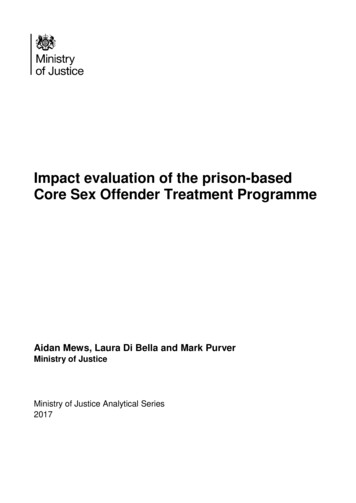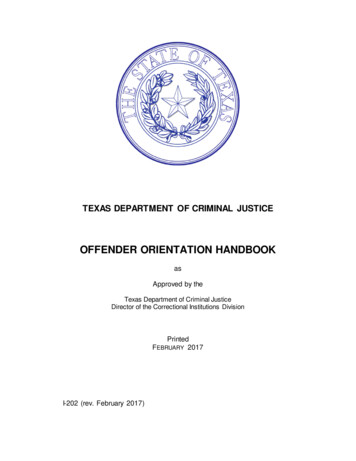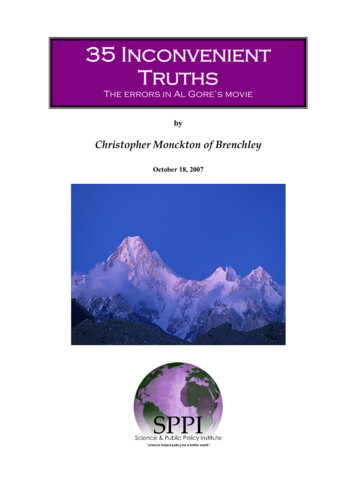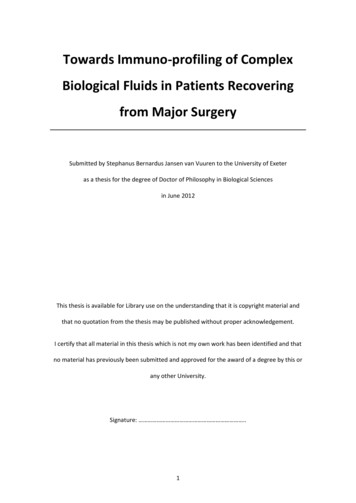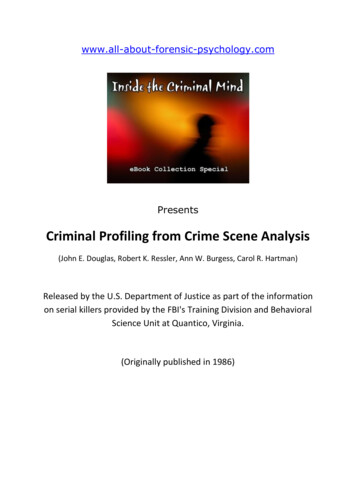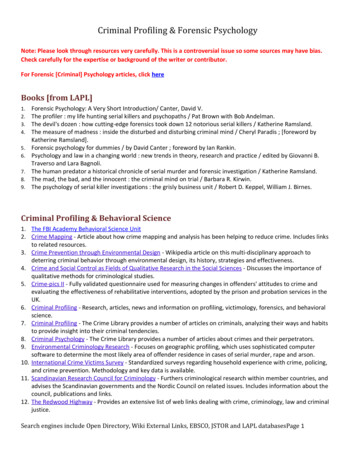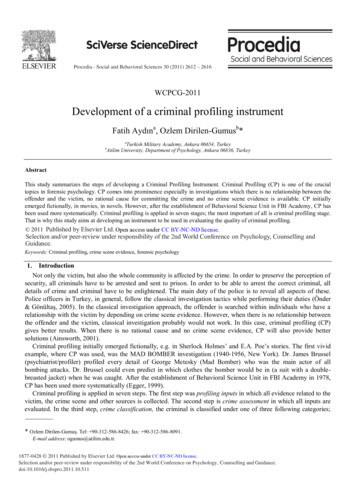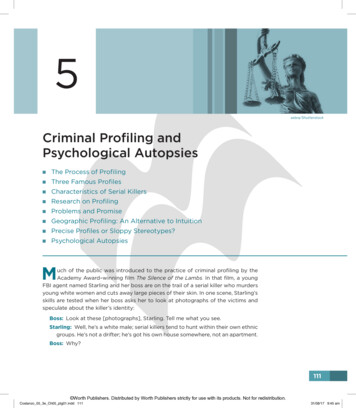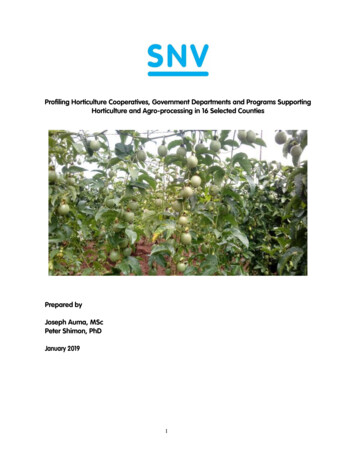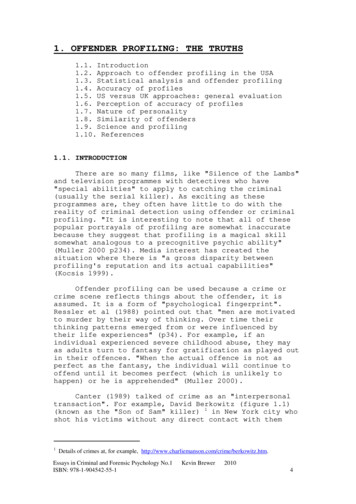
Transcription
1. OFFENDER PROFILING: THE TRUTHS1.1. Introduction1.2. Approach to offender profiling in the USA1.3. Statistical analysis and offender profiling1.4. Accuracy of profiles1.5. US versus UK approaches: general evaluation1.6. Perception of accuracy of profiles1.7. Nature of personality1.8. Similarity of offenders1.9. Science and profiling1.10. References1.1. INTRODUCTIONThere are so many films, like "Silence of the Lambs"and television programmes with detectives who have"special abilities" to apply to catching the criminal(usually the serial killer). As exciting as theseprogrammes are, they often have little to do with thereality of criminal detection using offender or criminalprofiling. "It is interesting to note that all of thesepopular portrayals of profiling are somewhat inaccuratebecause they suggest that profiling is a magical skillsomewhat analogous to a precognitive psychic ability"(Muller 2000 p234). Media interest has created thesituation where there is "a gross disparity betweenprofiling's reputation and its actual capabilities"(Kocsis 1999).Offender profiling can be used because a crime orcrime scene reflects things about the offender, it isassumed. It is a form of "psychological fingerprint".Ressler et al (1988) pointed out that "men are motivatedto murder by their way of thinking. Over time theirthinking patterns emerged from or were influenced bytheir life experiences" (p34). For example, if anindividual experienced severe childhood abuse, they mayas adults turn to fantasy for gratification as played outin their offences. "When the actual offence is not asperfect as the fantasy, the individual will continue tooffend until it becomes perfect (which is unlikely tohappen) or he is apprehended" (Muller 2000).Canter (1989) talked of crime as an "interpersonaltransaction". For example, David Berkowitz (figure 1.1)(known as the "Son of Sam" killer) 1 in New York city whoshot his victims without any direct contact with them1Details of crimes at, for example, ssays in Criminal and Forensic Psychology No.1ISBN: 978-1-904542-55-1Kevin Brewer20104
lived an isolated existence. The "psychologicalfingerprint" is easier to see when there are a series ofcrimes: serial murder, rape and sexual assault, burglary,arson, or nuisance/obscene phone calls.(Source: US Federal Gov; in public domain)Figure - Photograph and police sketch of David Berkowitzin 1977.Offender profiling has no universally accepteddefinition, and varies in its use in the USA and the UK.However, Douglas and Burgess (1986) defined it as "aninvestigative technique by which to identify the majorpersonality and behaviour characteristics of the offenderbased upon the analysis of the crime(s) he or she hascommitted" (p1). Table 1.1 summarises some otherdefinitions used.In the main, it involves the statistical analysis ofcrime data, behavioural science (including psychology),and detection expertise. It is "a technique for identifying the major personality andbehavioural characteristics of an individual based upon ananalysis of the crimes he or she has committed" (Douglas et al1986).It "focuses attention on individuals with personality traits thatparallel traits of others who have committed similar offences"(Pinizzotto and Finkel 1990).The "process of inferring distinctive personality characteristicsof individuals responsible for committing criminal acts" (Turvey1999).Assumes that the "interpretation of crime scene evidence canindicate the personality type of the individual(s) who committedthe offence" (Rossmo 2000).Table 1.1 - Some definitions of offender profiling.Essays in Criminal and Forensic Psychology No.1ISBN: 978-1-904542-55-1Kevin Brewer20105
1.2. APPROACH TO OFFENDER PROFILING IN THE USAIn the USA, offender profiling has been welldeveloped over the last thirty years 2 by the BehaviouralScience Unit at the FBI 3 (which was opened in 1972). TheFBI prefers to use the term "criminal investigationanalysis" (CIA) or "crime scene analysis". When appliedto murder cases, the profiler will be given a vast amountof information to assimilate (table 1.2) 4. Crime scene details: including photographs, and the medicalexaminer's report.Details of the victim ("psychological autopsy").Geographical profiling of the area where the crime(s) committed;eg: type of housing in the neighbourhood; average income ofresidents.Table 1.2 - Information given to a profiler after amurder.Pinizzotto and Finkel (1990) outlined five steps inthe profiling process:i) Assess the type of criminal behaviour withreference to who committed similar acts previously;ii) Analyse crime scene;iii) Study background of victim as well;iv) Establish motives of parties involved;v) Generation of characteristics or "psychologicalmake-up" of the offender.The aim of offender profiling is not to provide thespecific identity of the offenders, as in fiction, norwill the profiler necessarily be involved in the actualinvestigation. The aim is to give the police parametersin their search for suspects. These parameters mightinclude gender, educational level, or whether theoffender has previous criminal convictions. It is abouthelping to narrow down the field of many suspects. Aseries of murders could produce a list of hundreds ofpossible suspects.2The requests for profiling to the FBI rose from approximately 600 per year in 1986 to over 1200 by1996 showing its increasing popularity among police forces in the USA (Dowden et al 2007).3Official website at http://www.fbi.gov/homepage.htm.4The characteristics and typologies have been incorporated into "The Crime Classification Manual"(Ressler et al 1992).Essays in Criminal and Forensic Psychology No.1ISBN: 978-1-904542-55-1Kevin Brewer20106
The most important distinction in a murder is thatof organised/disorganised. The crime scene will giveclues to which one, and thus whether the offender isorganised or disorganised (table 1.3). Clearly differenttypes of suspects will be investigated in each case.Wilson et al (1997) preferred to see organised anddisorganised as two ends of a continuum.ORGANISED- PlannedDISORGANISEDMURDER SCENE- Spontaneous- Victim probably stranger- Victim known by offender- Control of victim used- Little control- Body hidden or attemptto hide- Body not hidden or no attemptto hide- Evidence hidden or removedeg: weapon used- No attempt to hide orremove evidenceMURDERER- More-than-averageintelligence- Less-than-averageintelligence- Controls own behavioureg: does not show anger ineveryday life- Uncontrolled behaviour- Socially competent- Socially incompetent- Follows murder on news- Does not follow on news- Limited change in behaviourafter crime- Major change in behavioureg: leaves town(After FBI 1985)Table 1.3 - Some of the main characteristics of organisedand disorganised murder scenes and murderers.It may be small details that the profiler providesthat can make the difference. For example, in thecapture of Arthur Shawcross 5 in 1990 in the Rochesterarea of New York state. The FBI profiler believed thatthe killer returned to the dead victims to re-experiencethe pleasure of the killing. The FBI surveillance of theeleventh female victim of Shawcross caught himmasturbating near the body (quoted in Brewer 2000).5Details of crimes at, for example,http://www.trutv.com/library/crime/serial killers/predators/shawcross/life 1.html.Essays in Criminal and Forensic Psychology No.1ISBN: 978-1-904542-55-1Kevin Brewer20107
1.3. STATISTICAL ANALYSIS AND OFFENDER PROFILINGThe most important technique for profilers is theuse of statistics. This is far from glamorous, but hoursin front of the computer screen looking for patterns canbe very helpful. The collection of data on crimes is thuscrucial. For example, in the USA, the FBI set up theViolent Crime Apprehension Program (ViCAP) computerdatabase on murders in 1995 6. While the Derbyshire policehave responsibility for the CATCH'EM (Central AnalyticalTeam Collating Homicide Expertise and Management)database of all child murders in the UK for the lastthirty years.Statistical analysis allows predictions about thekiller, and the establishing of patterns. For example,from CATCH'EM, the statistics show that if the victim ismale and under sixteen years of age, then in 83% of casesthe offender is single. Or if there has been sexualinterference with the child's body before the murder, inonly 1-2% of cases is the killer the parent(s) orguardian(s) (quoted in Brewer 2000).The creation of patterns and groupings of offendershave been used for serial murder and rape (Rossmo 1997;table 1.4); sexual assaults (Canter and Heritage 1990;table 1.5); and arson (Canter and Fritzon 1998; table1.6).1. Victim search method - how offender obtains victim.a) Hunter or marauder - looks for particular type of victimsnear offender's own home. 87% of British serial rapists lived within"offence circle" (Canter and Larkin 1993). The "offence circle is thegeographical clustering of the crimes. David Canter has developed acomputer programme ("Dragnet") to look at the geographical patternsof crimes. This process is known as geographical profiling ("MappingMurder" 2002) 7.b) Poacher or commuter - looks for particular victim away fromown home. 51% of US serial rapists lived outside their "offencecircle" (Reboussin et al 1993).c) Troller - opportunistic encounters with victims.d) Trapper - offender works in a job that allows them theopportunity to meet victims; eg: Gerald Schaeffer, who it is believedkilled over thirty women, was a US police officer 8.6This is a database of violent crimes and homicides, sexual assaults, missing persons and unidentifiedhuman remains (FBI no date).7The application of computer software using "circle theory" for 79 US serial killers identified 87% ofoffenders in 25% of locations (Coffey and Canter 2000). While a computer system called "CriminalGeographic Targeting" (CGT) plots the distance between crimes to produce a "jeopardy surface" whichis the probability of areas where the offender lives (Billingham, Brewer et al 2008).8Details of crime at, for example,http://www.trutv.com/library/crime/serial killers/predators/gerard schaefer/1.html?sect 2.Essays in Criminal and Forensic Psychology No.1ISBN: 978-1-904542-55-1Kevin Brewer20108
2. Victim attack method - when and where victim is attacked.a) Raptor - attacks victim on meeting wherever.b) Stalker - follows victim, and attacks when feelstime/situation is right.c) Ambusher - attacks when victim in situation controlled byoffender; eg: offender's home.Table 1.4 - Victim search and victim attack methods usedby serial murderers and rapists.How female victim treated by male sexual attacker (based onvictim statements of 66 UK sexual assaults).a) Victim as person - conversation during attack;compliments her appearance; attacker mistakenly believessexual assault is forming relationship, and may ask to seethem again; no disguise used.b) Victim as object - control of victim with blindfold andgagging; offender disguised; woman seen as dangerous byoffender.c) Victim as vehicle - violence (both physical and verbal)used and demeaning comments; attack is reflection ofoffender's anger.Table 1.5 - Examples of characteristics of threedifferent types of sexual assaults.42 offender variables summarised into four patterns of arson(based of 175 arson cases in England).a) Arson as "expressive object" - serial targeting ofparticular types of public buildings; prior convictions forarson; offender remains or returns to scene of crime.b) Arson as "expressive person" - arson as an attempt torestore emotional equilibrium, reduce distress, orattention-seeking; endangers lives; targets residentialproperty; use of multiple ignition points; may even usearson as suicide.c) Arson as "instrumental person" - specific target afterdispute between offender and victim; threats givenbeforehand.d) Arson as "instrumental object" - opportunist; emptyproperty targeted; group together rather than individualarsonist.Table 1.6 - Example of the characteristics of four typesof arson.Essays in Criminal and Forensic Psychology No.1ISBN: 978-1-904542-55-1Kevin Brewer20109
1.4. ACCURACY OF PROFILERSThe USA approach to offender profiling is classed asa "top-down" approach: interviewing criminals in prisonand using that information to understand criminalbehaviour. This has included asked convicted murders toprofile unsolved murders; eg: Ted Bundy was asked to helpwith a profile of the at the time unsolved forty-nine(probably) "Green River Murders". He was no help("Catching the Killer" 2001).The UK approach is more "bottom-up": working withdetails and building up specific associations betweenoffences and the offender's characteristics (Boon andDavies 1992).Many of the famous cases, particularly featured ontelevision documentaries, show the successes of offenderprofiling. David Canter, in the UK, has had famoussuccesses with his profiles of the "Railway Rapist" (JohnDuffy) (though subsequently there has been the convictionof an accomplice, David Mulcahy, for the crimes; "Witnessand Truth: Railway Murders" 2001), and the serial rapistof elderly women, Adrian Babb, in Birmingham (both in the1980s) (details of the cases in Canter 1994).However, there are some who are critical ofprofiling generally:The cerebral sleuth relying solely on his acutepowers of observation and deductive reasoning toidentify an elusive and much feared serial rapistor murderer, is of immediate and obvious appeal.The seduction is such that many profilers havebegun to believe their own press (Grubin 1995 p262).But how to accurately evaluate profilers other thanthrough anecdotes? Three methods have been tried surveys, experiments, and historical analysis. Here areexamples of each of these methods.1. SurveysCopson (1995) set out to find how useful the policethemselves found offender profilers. A survey was sentout to 48 UK police forces. A large number of policeforces (82.6%) did find the profiler "operation
Essays in Criminal and Forensic Psychology No.1 Kevin Brewer 2010 ISBN: 978-1-904542-55-1 4 1. OFFENDER PROFILING: THE TRUTHS 1.1. Introduction 1.2. Approach to offender profiling in the USA 1.3. Statistical analysis and offender profiling
